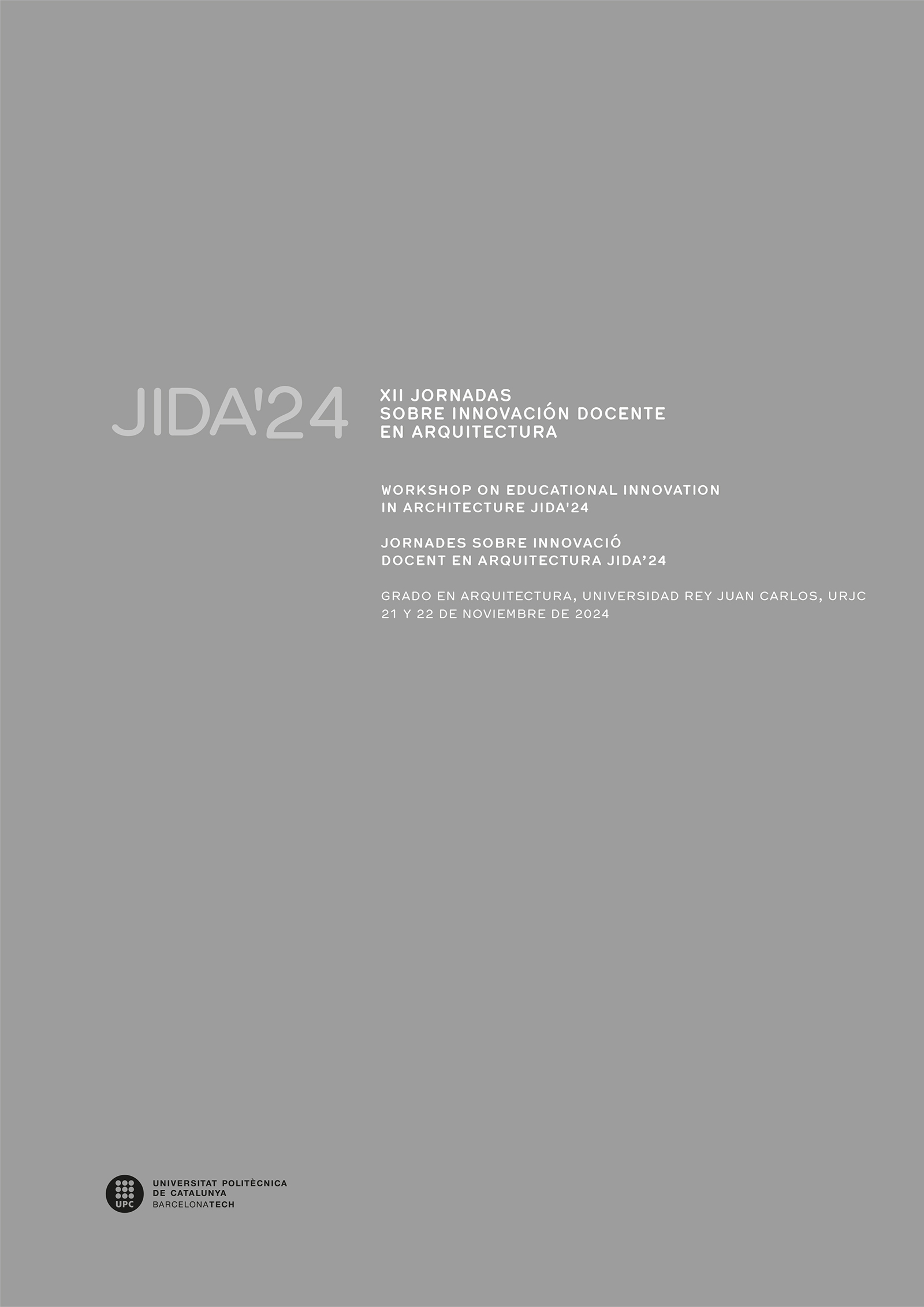The Digital Twin in Architecture: integrating environmental aspects into the design process
DOI:
https://doi.org/10.5821/jida.2024.13266Keywords:
architecture, digital twin, process of project, sustainabilityAbstract
The document examines the use of Digital Twins in architecture as a key tool for integrating environmental aspects into the design process. Defined as a real-time digital representation of a physical system, the Digital Twin allows for the simulation and prediction of architectural outcomes, facilitating decision-making based on complex data. This technology is particularly useful in architectural education, enabling students to experiment with and adjust designs in a virtual environment, fostering more practical and critical learning. The text highlights that the implementation of Digital Twins not only improves resource efficiency and reduces environmental impact but also transforms architectural education, promoting a more active and collaborative role for both students and educators.
References
EVA
Badia, A., Bautista, G., Guasch, T., Sangrà, A., y Sigalés, C. 2004. «La integración escolar de las TIC: el Proyecto Ponte dos Brozos». FUOC, Sept 2004. http://www.uoc.edu/dt/esp/badia0904.pdf
Maldonado-Mangui, S. P., Peñaherrera-Acurio, W. P., y Espinoza-Beltrán, P. S. 2020. «Los Entornos Virtuales de Aprendizaje (EVA's), como recurso de aprendizaje en las clases asíncronas de las IES». Dominio de las Ciencias, 6(4), 1279-1291. https://doi.org/10.23857/dc.v6i4.1306
Gemelo Digital
Chevallier, Z., Finance, B., y Cohen Boulakia, B. 2020. «A Reference Architecture for Smart Building Digital Twin». En SeDiT 2020 University of Versailles-Saint-Quentin-en-Yvelines. https://www.researchgate.net/publication/340621918_A_Reference_Architecture_for_Smart_Building_Digital_Twin
Fuller, A., Fan, Z., y Day, C. 2019. «Digital Twin: Enabling Technology, Challenges, and Open Research». IEEE Access, vol. 8, pp. 108952-108971, 2020. https://ieeexplore.ieee.org/document/9103025.
Grieves, M. 2011. Virtually Perfect: Driving Innovative and Efficient Product Creation. New York: Space Coast Press.
Glaessgen, E., y Stargel, D. 2012. «The Digital Twin Paradigm for Future NASA and U.S. Air Force Vehicles». En 53rd Structures, Structural Dynamics, and Materials Conference, American Institute of Aeronautics and Astronautics. DOI:10.2514/6.2012-1818
Liu, Z., Meyendorf, N., y Mrad, N. 2018. «The Role of Data Fusion in Predictive Maintenance Using Digital Twin». En 44th Annual Review of Progress in Quantitative Nondestructive Evaluation, Volume 37. Springer. DOI:10.1063/1.5031520
Lu, Q., Parlikad, A. K., Woodall, P., Don Ranasinghe, G., y Heaton, J. 2019. «Developing a Dynamic Digital Twin at a Building Level Using Cambridge Campus as Case Study». International Conference on Smart Infrastructure and Construction 2019 (ICSIC): Driving data-informed decision-making 36(3). DOI:10.1061/(ASCE)ME.1943-5479.0000763
Wang, M., Ashour, M., Mahdiyar, A., y Sabri, S. 2024. «The Effectiveness of a Digital Twin Learning System in Assisting Engineering Education Courses: A Case of Landscape Architecture». Applied Sciences, 14(6484), 30. DOI:10.3390/app14156484
Wang, M., Ashour, M., Mahdiyar, A., y Sabri, S. 2024. «Opportunities and Threats of Adopting Digital Twin in Construction Projects: A Review». Buildings, 14(2349). https://doi.org/10.3390/buildings14082349
Zhang, H., Zhou, Y., Zhu, H., Sumarac, D., y Cao, M. 2020. «Digital Twin-Driven Intelligent Construction: Features and Trends». Structural Durability & Health Monitoring, 15(3):183-206 15(3):183-206. DOI: 10.32604/sdhm.2021.018247
GIS y GRASHOPPER PLUGINS (LADYBUG, HONEYBEE, BUTTERFLY)
Barzegar Ganji, H., Utzinger, D. M., y Bradley, D. E. 2019. «Create and Validate Hybrid Ventilation Components in Simulation using Grasshopper and Python in Rhinoceros». En 16th IBPSA Conference. IBPSA, 4345-4352. https://doi.org/10.26868/25222708.2019.211292
Konis, K., Gamas, A., y Kensek, K. 2016. «Passive performance and building form: An optimization framework for early-stage design support». Solar Energy 125(1): 161-179. DOI:10.1016/j.solener.2015.12.020
Mackey, C., Galanos, T., Norford, L., y Sadeghipour Roudsari, M. 2017. «Wind, Sun, Surface Temperature, and Heat Island: Critical Variables for High-Resolution Outdoor Thermal Comfort». En 15th IBPSA Conference. IBPSA, 985-993. https://doi.org/10.26868/25222708.2017.260
Ramos Carranza, A., y Añón Abajas, R. M. (Eds.). 2020. «Proyecto, Progreso, Arquitectura: Arquitectura e investigación aplicada». Visiones heterogéneas (Nº 22). Editorial Universidad de Sevilla. https://dx.doi.org/10.12795/ppa
Rojas Fernández, J. M. 2017. Termodinámica del patio mediterráneo: Cuantificación y aplicación al diseño de arquitecturas eco-eficientes. Tesis doctoral, Universidad de Sevilla. Escuela Técnica Superior de Arquitectura de Sevilla. https://issuu.com/hombredpiedra/docs/01_termodin_mica_del_patio_juan_man



















